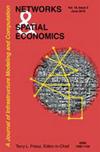Comparative Analysis of the Spatial Structures of the Moscow and St. Petersburg Agglomerations
IF 1.5
3区 工程技术
Q3 OPERATIONS RESEARCH & MANAGEMENT SCIENCE
引用次数: 1
Abstract
The article provides a comparative analysis of the existing spatial structure of urban settlement of the two largest agglomerations of our country – Moscow and St. Petersburg. Quantitative (dynamics of the number of settlements with the status of a city, dynamics of the population of cities, the number of houses under construction and the total area of residential units under construction) and qualitative (analysis of the automobile and railway networks) indicators are used. The following scientific methods are used in the work: statistical, geostructural, cartographic modeling, grouping method. 2002–2021 the two agglomerations are characterized by positive trends in population growth, which are associated with migration growth. The supporting framework of the Moscow agglomeration is represented by a uniform radial-circular type with a mixed monopolycentric model with a dominant core and the presence of large sub-centers, while the St. Petersburg agglomeration is a coastal type with a pronounced monocentric model and exclusive dominance of the core. On the basis of the existing supporting frames, to determine the stages of development of two agglomerations, a spatial typology of cities was carried out depending on the degree of their remoteness from the corresponding central points (nuclei). As a result, five orders (belts) with averaged transport availability isochrones were identified. Transformation processes of staged agglomeration development proceed most intensively within the entire Moscow agglomeration, which is at the stage of suburbanization. In the St. Petersburg agglomeration, the most active urbanized zone are cities located at distances of up to 50 km from the central point of the core, and it is characterized by a transition from the urbanization stage to the suburbanization stage莫斯科与圣彼得堡城市群空间结构的比较分析
本文对我国两个最大城市群——莫斯科和圣彼得堡的现有城市聚落空间结构进行了比较分析。使用了定量指标(城市地位的住区数量动态、城市人口动态、在建房屋数量和在建住宅单元总面积)和定性指标(汽车和铁路网络分析)。在工作中使用了以下科学方法:统计方法、地质构造方法、制图建模方法、分组方法。2002-2021年,这两个城市群的特点是人口增长呈积极趋势,这与移民增长有关。莫斯科城市群的支撑框架为统一的径向-圆形型,具有混合的多中心模式,核心占主导地位,并存在大型副中心;圣彼得堡城市群为沿海型,单中心模式明显,核心占主导地位。在现有支撑框架的基础上,为了确定两个城市群的发展阶段,根据其与相应中心点(核)的距离程度,进行了城市的空间类型学。结果,确定了具有平均运输可用性等时线的五个订单(带)。在整个莫斯科城市群内,阶段性集聚发展的转型过程最为密集,处于郊区化阶段。在圣彼得堡城市群中,最活跃的城市化区域是距离核心中心点50公里以内的城市,其特征是从城市化阶段向郊区化阶段过渡
本文章由计算机程序翻译,如有差异,请以英文原文为准。
求助全文
约1分钟内获得全文
求助全文
来源期刊

Networks & Spatial Economics
社会科学-运筹学与管理科学
CiteScore
4.00
自引率
4.20%
发文量
26
审稿时长
>12 weeks
期刊介绍:
Networks and Spatial Economics (NETS) is devoted to the mathematical and numerical study of economic activities facilitated by human infrastructure, broadly defined to include technologies pertinent to information, telecommunications, the Internet, transportation, energy storage and transmission, and water resources. Because the spatial organization of infrastructure most generally takes the form of networks, the journal encourages submissions that employ a network perspective. However, non-network continuum models are also recognized as an important tradition that has provided great insight into spatial economic phenomena; consequently, the journal welcomes with equal enthusiasm submissions based on continuum models.
The journal welcomes the full spectrum of high quality work in networks and spatial economics including theoretical studies, case studies and algorithmic investigations, as well as manuscripts that combine these aspects. Although not devoted exclusively to theoretical studies, the journal is "theory-friendly". That is, well thought out theoretical analyses of important network and spatial economic problems will be considered without bias even if they do not include case studies or numerical examples.
 求助内容:
求助内容: 应助结果提醒方式:
应助结果提醒方式:


